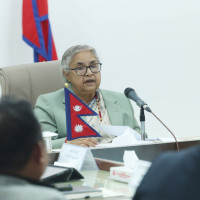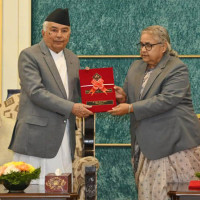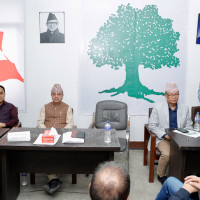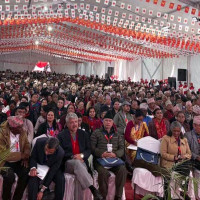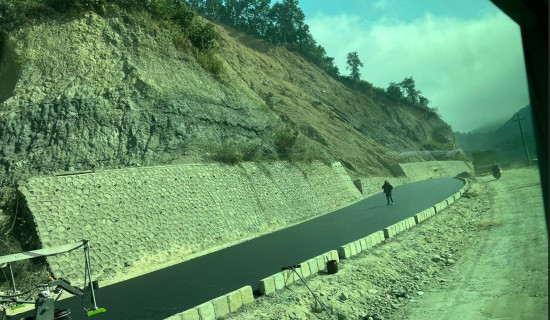- Monday, 15 December 2025
Infrastructure, Job Creation In Priority
With the new fiscal year commencing soon, all three-tier governments have been engaged in budgetary processes. The existing constitutional and legal provisions have made it mandatory for the federal government to unveil its annual budget in the joint session of parliament on Jestha 15. Even amid disruptions in parliamentary proceedings, the federal government was able to unveil its budget on schedule. The House of Representatives has recently approved the new budget. Provincial governments and local governments are required to submit their financial plan in the provincial assemblies and municipal and/or village assemblies by Asar 1 and Asar 10, respectively. Gandaki Province has come out first to get its budget endorsed by the provincial assembly, while other provinces have been busy discussing their respective budgets.
Provinces and local levels in Nepal have been recognised constitutionally as autonomous bodies within the federal setup. They enjoy their distinct powers and responsibilities. However, they are obliged to prepare their budgets in line with the principle of fiscal federalism. There should be coordination and cooperation among all tiers of government in terms of fiscal matters and sharing of incomes as they collect resources and spend them to deliver services to people. Their performance should also remain focused on attaining national goals.
Financial crunch
Preparing a desired and effective budget is both an opportunity and a challenge for every government. It is more so for local governments in view of their weak capacity. However, the federal constitution envisages taking the ‘Singha Durbar to the doorsteps of everyone’. So, local levels have been authorised and empowered to come up with necessary policies, plans and budgets for local development. The roles of local governments in the delivery of public services are very important as they work closely with people. Because local governments are quite familiar with local needs, problems, and development prospects and challenges, among others, it becomes easier for them to work with people. But the local authorities are bound to reel from various constraints, including a financial crunch and a dearth of expertise for effective planning.
Since the first three-tier elections held in 2017, local governments have been carrying out their responsibilities in line with the concept of federalism. During this period, many local levels have done much better when it comes to improving their service delivery, while the performance of others has yet to remain up to the mark.
According to media reports, 114 local levels out of 753 have presented their budget for the upcoming fiscal year 2025-26 by meeting the legal deadline. Looking at their budget priorities, most local levels in outlying parts of the country have prioritised physical infrastructure development in their budget. Other local governments have introduced numerous projects related to infrastructural development, skills development, employment promotion, communications and technological development, climate change and disaster management. Many local levels have put much emphasis on education, health, technology transfer, commercialisation of agriculture, heritage and environmental conservation, and entrepreneurship development. As a metropolis having enormous tourism potential, Pokhara has accorded top priority to the promotion of the multifaceted tourism industry.
Figures show that as many as 39 local levels, including Kathmandu Metropolitan City (KMC), have failed to introduce their annual budget on time. Internal disputes (among the elected people’s representatives or between the elected representatives and the chief executive officer) are a major reason for local governments’ inability to announce budgets on time. Except KMC, all other metropolises (Lalitpur, Pokhara, Bharatpur, Birgunj and Biratnagar) have introduced their budget within the deadline.
KMC is the only metropolis in the country and local level in the Kathmandu Valley to miss the budget deadline. Dharan Sub-metropolitan City is also the only sub-metropolis that has been unable to table its budget on schedule. A protracted clash between KMC Mayor Balendra Shah and the chief administrative officer, Saroj Guragain, is reported to have led to such a situation. Though Deputy Mayor Sunita Dangol and ward chairmen constantly requested Mayor Shah to convene a meeting of the municipal executive council for finalising the budget, the latter kept showing his reluctance on the matter. In Dharan, the municipal assembly could not approve the budget owing to a longstanding conflict between Mayor Harka Sampang and the Deputy Mayor and ward chairmen. They have blamed each other for their failure to declare the budget.
In Saptari district alone, eleven local levels could not introduce the budget on schedule. Despite being the district headquarters, Rajbiraj Municipality is also among the local levels failing to meet the legal deadline for the budget. This scenario is a clear indication that the local level leadership is not serious about performing their duties in a responsible and accountable manner.
Public participation
When the annual budget is not unveiled on time, it definitely raises grave concerns over service delivery, hampering people’s well-being. At a time when the common people are not so much satisfied with the performance of local governments, the negligence on the part of such responsible sub-national bodies, even to present the annual budget on time, may cause more frustrations to them. This may lead to a decrease in people’s participation in governance.
There has also been a tendency among local governments to prepare a budget without doing proper homework. It is necessary for the elected representatives to draft policies, plans and budgets as per people’s aspirations. Such governments need to encourage citizens to take part in the planning and budgeting process to ensure that the budget reflects the latter’s needs and priorities. Local levels should also strive for self-sustainability in financial resources. As fiscal irregularities and policy-level corruption cases appear to have been on the rise at local levels, efforts must be geared towards making local governments accountable and transparent. The political parties, anti-graft bodies and local citizens should play a crucial role in this connection.
(The author is a former deputy executive editor of this daily.)




